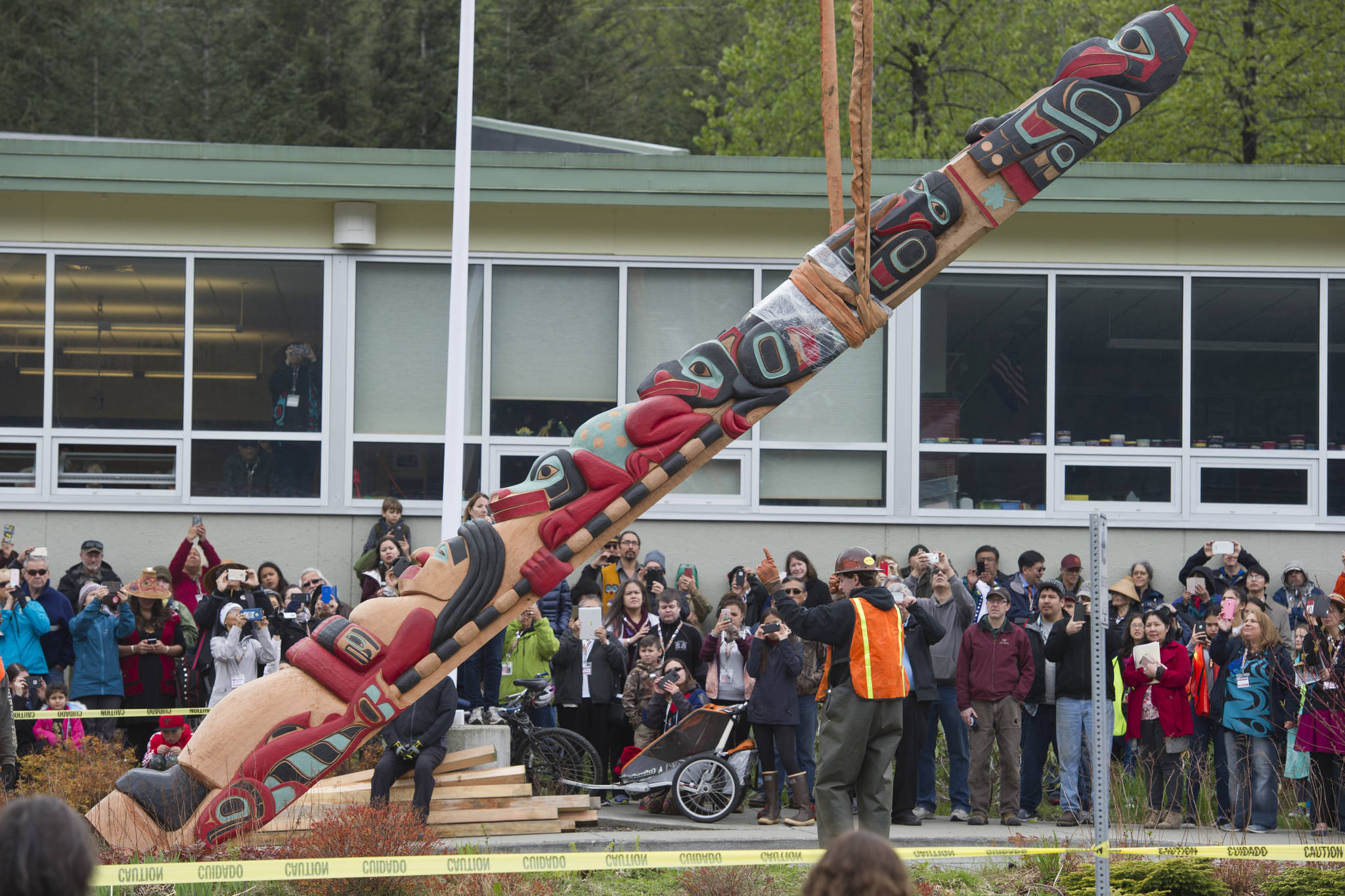In one way, Saturday’s totem pole raising ceremony at Gastineau Elementary School felt like the culmination of a decades-long process. At the same time, those on hand were excited for it to mark the beginning of a new era as well.
Sixty-one years after the City of Juneau paved over a Native burial ground to build a highway and the school, the Douglas Indian Association (DIA) and Goldbelt Heritage collaborated to raise a Raven healing totem pole that honored ancestors who had been buried there and the grief that followed.
As she introduced the ceremony, DIA Tribal Administrator Andrea Cadiente-Laiti was looking to the future.
“What’s happening today is going to be enormous,” Cadiente-Laiti said, “and it’s just the start.”
A couple hundred community members showed up for the ceremony Saturday morning, despite the chilly, windy conditions. The pole went up just before noon, beginning with a group of people lifting it and carrying it into position for a large crane to finish the job. It took more than 40 people to lift the 26-foot pole and carry it a few feet at a time, with dozens more surrounding them to both offer encouragement and document the moment with their phones.
As the crane lowered the pole into its location in front of the school, facing the Gastineau Channel, a few of the carvers gathered directly in front of it. Master Carver Mick Beasley said he was pleased with the result and especially liked the pole having the mountains behind it.
Herb Sheakley, the Lead Apprentice Carver on the project, noted how different the finished product looked when it was standing upright as opposed to laying horizontally. This was Sheakley’s first totem pole, and it served as both an artistic and historical education for him. Sheakley, a Chookaneidi Tlingit, quickly learned of the destruction of the burial ground and the grief it caused.
“I knew there was a gravesite here, but where, I was unsure of,” Sheakley said. “It was something that, over time, everybody not talking about it kind of just made everybody forget about it. So now it’s something that people won’t forget.”
The Raven pole is the first part of a project that honors both the destruction of the graveyard and the burning of the Douglas Indian Village in 1962. The second pole will be an Eagle Pole located at Savikko Park to commemorate the burning of the village. Many of the same carvers will work on the second pole as well.
Master Carver Nathan Jackson designed the Raven pole, which began being carved in May 2016. Beasley, as Sheakley put it, made Jackson’s design “come to life.” Fred Fulmer was the Mentor Carver, and apprentices Elijah Marks, Jeffrey Isturis and Sam Sheakley all worked on it as well.
Saturday’s event included prayers, ceremonies and numerous speakers. Cadiente-Laiti was the keynote speaker, while Tradition Bearer David Katzeek took center stage for the ceremony itself. As he looked out into the crowd — with Eagle elders to his left and Raven elders to his right — Katzeek expressed his excitement for the diverse turnout.
“This is how community is,” Katzeek said, his voice gaining more intensity and emotion as he went on. “This is real community. This isn’t just saying, ‘I’m this and I’m that and I live here and I did this and I went there and I can say this and I know this and I know that.’ This is community. We’re here, we’re healing, and so I’m here to encourage you, to uplift you, to stand with you.”
That community feel was clear throughout. Young children played both on the lawn of the school and in the school’s gymnasium during the ceremony, and there was a room inside specifically for elders. Snacks and coffee were available, and midway through the ceremony, sandwiches and Goldfish crackers were distributed.
There was an emphasis on the young people present. Though they didn’t live through the events of the 1950s and 1960s, the effects of efforts to smother Native culture reverberate to the present. As Sheakley said, a great deal of culture has been forgotten. Recently, there’s been a movement to revive Native language and culture, and Saturday’s ceremony was a part of that.
With a totem standing on the former burial ground and current school, there’s now a physical reminder of the past, which Cadiente-Laiti and others hope is also a sign of change to come.
“It starts with us,” Cadiente-Laiti said, “and our children will feel what we do here today.”
• Contact reporter Alex McCarthy at alex.mccarthy@juneauempire.com or 523-2271.

